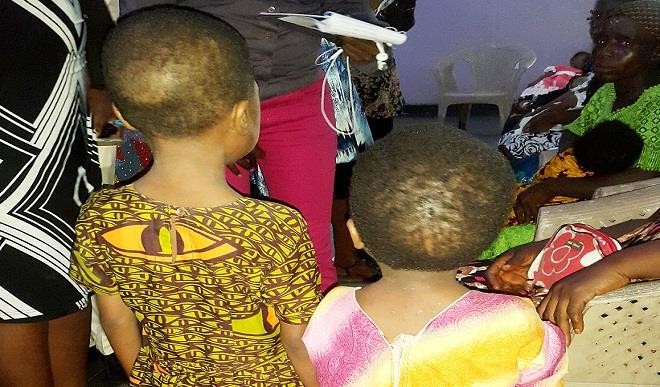
Six-year-old Chilotaram Mba looked skinny and sickly. Her height is a sharp contrast to her age as anyone could easily mistake her for a child half her age.
Her four-year-old sister, Princess Mba, is also in the same condition.
Their aunt, Agatha Mba, who translates on behalf of their mother (because she does not speak English), narrates their stories saying that the doctors had diagnosed her two nieces as being malnourished and in need of treatment.
But the contrast is that these kids are from Enugu State, where the communities boast of surplus of greens and vegetables, foods, tubers and fruits.
In Nigeria as a whole – from the east, west, north and south – most parts of the regions are endowed with different types of food, fruits and vegetables, yet the scourge of malnutrition is still recorded.
A quick survey of some Nigerian markets by the Homefront showed that foodstuffs are overflowing them, as there is abundance of all kinds of food items such as millet, sorghum, coconuts, sweet potatoes, tomatoes, dried chilies and fruits like, mangoes, oranges, pawpaw and avocado pear across most regions.
But despite this blessing, which shows surplus of food, children still suffer malnutrition, with the country losing about 2,300 under five year children and 145 women yearly.
The United Nations Children’s Emergency Fund (UNICEF) revealed that the underlying factor of child and maternal morbidity in Nigeria is malnutrition, adding that although many of these deaths were preventable, coverage and quality of treatment are lacking.
Malnutrition is a condition that occurs when people consistently do not consume or absorb the right amounts and types of food and essential nutrients. Globally, it contributes to nearly half of all child deaths resulting in more than three million children each year.
Mrs. Herriatha Ugwu, the State Nutrition Officer, Enugu State Ministry of Health, explained that the main indicator of childhood malnutrition is stunting; when children are too short for their ages leading to poor physical growth and brain development and preventing them from thriving and living up to their full potentials.
She added that the case of stunting is irreversible, because it has already disrupted the child’s brain and it’s development.
She said right from the conception of the child in the mother’s womb, the countdown of the 1,000 days of the child begins, the kind of food the mother eats and passes to the child is of paramount importance.
“When the child is born, the most important factor is for the mother to start breast feeding the child immediately, putting the child to the breast, and to continue to breast feed the child exclusively for six months. This saves the child from a lot of childhood diseases and especially malnutrition, and its free and cheap.
“But unfortunately most mothers don’t do this; they start giving some kinds of liquids, endangering the lives of their babies.
“Another sad truth is that most women do not go for antenatal when they are pregnant, so all these teachings on what to eat, or feed the child, the mothers do not get the information,” she said.
Ugwu revealed that though some of the women engage in some petty trading or small scale farming around their homes, they rather sell the products to get money than use the food to feed their family.
Speaking on extreme cases of stunting when the damage has already set in, Mrs Ugwu added that the only treatment they can give, is to teach the caregivers different ways of preparing locally available food for their children.
“But there is the RUTF from UNICEF which when given to any malnourished child, within the space of 10 days the child will bounce back to life. Our former malnutrition specialist calls it a miracle food because immediately you start giving them RUTF they jack back to life,” she said.
Agatha recalled when she got to the village and saw that her brother’s children were looking sickly and she had to intervene by taking them to the health centre where it was discovered that the two girls were malnourished and did not have enough blood.
“The doctor wrote some drugs for me to buy and I did but they couldn’t continue with the drugs because of lack of money. Their father is just a palm wine tapper while their mother does petty trading. I also learnt that the children were not well fed with the right food that their body needs to grow properly,” she said.
Agatha, who brought the two girls to Enugu when she heard of the assistance the United Nations International Children’s Fund (UNICEF) was rendering to children affected by malnutrition, said the children eat majorly yam, rice, and ‘akpu’ but could not tell exactly the mode of preparation their mother made.
According to her, the situation is better now compared to when she took them to the hospital about two months ago.
The Head of Nutrition, Federal Ministry of Health, Dr Chris Isokpunwu, presenting a paper titled, ‘Scaling Up Nutrition in Nigeria: What Will it Cost?’ at the workshop, revealed that the Nigerian government would need $912 million over a period of five years to implement its National Nutrition Intervention Plan (NNIP) to check the menace of malnutrition resulting in high rate of infant and mother mortality across the country.
He added that if the plan is implemented, it would save about 890,000 stunting cases and 123,000 lives within five years.
Dr Isokpunwu said though nearly one million children under the age of five died in Nigeria yearly die to malnutrition related cases, most of other deaths were not reported.
“You only hear that a child died of malaria, diarrhoea, cholera and other diseases,” he said, noting that the sure way of tackling the issue of malnutrition was through immunisation but that it was useless when the child has already become malnourished; so prevention is better then cure,” he said.
The nutritionist noted that there should be behavioural change intervention, micronutrient and de-worming intervention, complimentary and therapeutic feeding intervention as a deliberate focus on children under five and the first 1000 days once the woman gets pregnant.
These, Isokpunwu added, will go a long way in curbing the increasing cases of malnutrition and also scaling up the campaign for the use of ORS and zinc oxide in treatment.
He lamented that unfortunately, malnutrition was sometimes fuelled by the society, household and individual influences based on diverse opinions about how a child should be fed.
A Nutrition Specialist with UNICEF, Ngozi Onuorah, said inadequate government commitment and funding for nutrition programme has been one of the reasons for the increase in malnutrition cases in the country.
She said funding for nutrition must be increased and released for nutritional intervention for children which, according to her, has not yet been done.
Other challenges she numerated include, “inadequate government commitment, poorly motivated workforce, poor salary structure and non-payment of salaries in some states, poor attitude of health workers, poorly coordinated health interventions in states by staff who see nutrition programmes as supplementary immunisation activity and so do not pay attention to the major drives.”
Dr Ken Ozoemena, a social policy specialist working with UNICEF, reeling out some statistics during his presentation on, ‘Child Friendly Budgeting; Addressing Child Malnutrition’, noted that over 11 million U5s Nigerian children are stunted, ranking Nigeria 2nd only to India.
He said also that Nigeria accounts for one-tenth of the global burden of Severe Acute under-five Malnutrition (SAM) with 37% of U5 Nigerian children stunted, 29% underweight, and 18% wasted.
According to him, 2,300 U5 Nigerian children die every day – more than a half of these deaths are related to malnutrition causes while presently the country is battling to treat 2.5 million under-five children severely malnourished.
His words: “About 30% of Nigerian children are underweight (don’t weigh enough for their age), more than double the proportion of underweight Ghanaian children.”
However, there is hope if the country is to save its future leaders.
N2.3 billion is required per round to implement the minimum package of nutrition intervention said a UNICEF nutritionist.
He added that though UNICEF and its partners are supporting the programme, an average of N68 million is needed per state for each round.
“What are we waiting for already, to save our future presidents and leaders from ruins of malnutrition,” Ozoemena said.

 Join Daily Trust WhatsApp Community For Quick Access To News and Happenings Around You.
Join Daily Trust WhatsApp Community For Quick Access To News and Happenings Around You.


